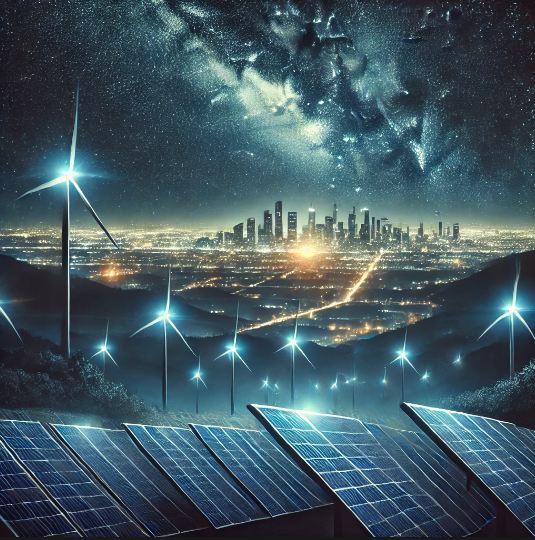India, one of the world’s fastest-growing economies, faces an escalating demand for energy resources. As urbanization, industrialization, and population growth continue at a rapid pace, the country is witnessing an exponential increase in its energy consumption. The energy demand in India is expected to double by 2040, according to reports from the International Energy Agency (IEA). This growing demand has led to significant concerns about sustainability, environmental impacts, and energy security. The challenge, however, presents an opportunity for India to transition toward renewable and sustainable energy sources to meet its needs while addressing climate change. This article explores the steps India is taking to meet its energy demands with a special focus on renewable energy resources.
1. Current Energy Landscape in India
India’s energy consumption has been on a steady rise, and it is now the third-largest energy consumer globally, after the United States and China. The major sources of energy in India include coal, natural gas, and oil, with a heavy reliance on coal for power generation. In 2020, coal accounted for approximately 55% of India’s total electricity generation. Despite this reliance on fossil fuels, India is making strides in diversifying its energy mix, focusing particularly on renewable energy sources.
2. Renewable Energy in India: An Overview
Renewable energy has become the cornerstone of India’s strategy to meet the growing energy demand in an environmentally sustainable way. India has abundant renewable energy resources, including solar, wind, hydro, biomass, and geothermal energy. As of 2023, India is one of the world’s leading producers of renewable energy, with the country having set ambitious targets for increasing the share of renewables in its energy mix.
2.1 Solar Power
India is endowed with abundant solar energy resources, especially in the western and southern regions. The government has recognized the potential of solar power as a key driver for future energy security. India’s National Solar Mission, launched in 2010, set an initial target of 20 GW of solar power capacity by 2022, which was later increased to 100 GW. The country is on track to surpass this target, with solar power contributing significantly to the national grid.
India’s government has introduced several policies to incentivize solar power generation. These include providing tax incentives, subsidies, and facilitating land acquisition for solar parks. The development of solar parks, such as the Bhadla Solar Park in Rajasthan, has been a major step forward, with the country rapidly scaling up its solar power capacity.
2.2 Wind Energy
India is also a major player in wind energy production. The country has a vast coastline, making it an ideal location for wind farms. The government has set a target of 60 GW of installed wind power capacity by 2022. Tamil Nadu, Gujarat, Maharashtra, and Karnataka are some of the leading states in terms of wind energy generation. India’s wind energy sector has seen significant investment in both onshore and offshore wind farms, with companies and foreign investors showing interest due to favorable policy conditions and growing market potential.
2.3 Hydropower
Hydropower remains one of India’s oldest and most reliable sources of renewable energy. Although the country has limited untapped hydropower potential, there is still room for expansion in the sector. The government has been focusing on the development of small and medium-sized hydro projects. The total installed capacity of hydropower in India stood at around 46 GW in 2023, with potential for further growth in the coming years.
However, environmental concerns and delays in project implementation have slowed the growth of hydropower projects. Still, hydropower continues to play an important role in balancing the intermittent nature of solar and wind energy.
2.4 Biomass and Bioenergy
India also has a large potential for biomass energy, particularly in rural areas where agricultural residues, such as crop stubble and animal waste, are abundant. Biomass can be used for power generation, heating, and producing biofuels. The government is working to promote biomass-based power generation through various subsidies and incentives for entrepreneurs and farmers.
In addition, the biofuels sector is gaining traction, with the introduction of the National Biofuels Policy to promote the use of ethanol and biodiesel in the country. This initiative aims to reduce dependence on fossil fuels and create a more sustainable energy system.
2.5 Geothermal Energy
Though not as developed as solar or wind energy, geothermal energy also holds promise for India. The country has several geothermal potential sites, particularly in regions such as Ladakh and the Himalayas. While this source of energy is still in the early stages of exploration and development, it could play a role in diversifying India’s energy mix in the future.
3. Government Policies and Initiatives
To accelerate the shift toward renewable energy, the Indian government has implemented several policies and frameworks aimed at scaling up clean energy deployment and achieving sustainability.
3.1 National Action Plan on Climate Change (NAPCC)
Launched in 2008, the NAPCC is a comprehensive framework for addressing climate change and promoting sustainable development in India. It includes the National Solar Mission, National Wind Energy Mission, and National Mission for Enhanced Energy Efficiency, all of which are central to India’s renewable energy strategy. The NAPCC emphasizes the integration of renewable energy sources into the national grid while promoting energy efficiency.
3.2 Renewable Energy Targets
India has set ambitious renewable energy targets under its Nationally Determined Contributions (NDCs) as part of the Paris Agreement. The target is to achieve 500 GW of non-fossil fuel-based energy capacity by 2030, which includes a substantial contribution from solar and wind power. Additionally, India aims to have 50% of its total electricity generation capacity come from renewable sources by 2030.
3.3 Solar Park and Wind Corridor Initiatives
To support the rapid expansion of renewable energy, India has initiated the development of large-scale solar parks and wind corridors. The government has allocated large tracts of land for these projects and has provided financial incentives. As of 2023, India has established numerous solar parks, such as the Rewa Ultra Mega Solar Park and Pavagada Solar Park, which have significantly contributed to the country’s solar capacity.
Similarly, wind corridors are being developed along the western coast of India to tap into the high wind energy potential.
3.4 Green Energy Corridors
The development of green energy corridors is another critical initiative for ensuring the efficient transmission of renewable energy. The Indian government is building dedicated transmission lines that connect renewable energy projects to the national grid. These corridors will facilitate the integration of solar, wind, and other renewable energy sources, ensuring that energy can be transferred across regions without significant loss.
3.5 Incentives and Financing Mechanisms
India has introduced several financial mechanisms to encourage private investment in the renewable energy sector. The government provides various subsidies, tax exemptions, and low-interest loans to renewable energy projects. Additionally, India has set up institutions like the Indian Renewable Energy Development Agency (IREDA) to promote investments in clean energy.
4. Challenges in the Transition to Renewable Energy
While India has made remarkable progress in expanding its renewable energy capacity, several challenges remain in fully transitioning to a sustainable energy future.
4.1 Intermittency and Storage
Renewable energy sources such as solar and wind are intermittent, meaning their energy generation is dependent on weather conditions. This creates challenges for ensuring a stable and reliable supply of energy. India needs to invest in advanced energy storage technologies, such as battery storage systems, to mitigate this issue and ensure energy reliability.
4.2 Grid Integration and Infrastructure
The existing energy grid infrastructure in India is not fully equipped to handle the large-scale integration of renewable energy. Significant upgrades to the grid are required to accommodate fluctuating energy inputs from renewable sources. The establishment of green energy corridors is a step in the right direction, but further investment in grid modernization is essential.
4.3 Land and Environmental Concerns
While India has abundant land for solar and wind projects, acquiring land for large-scale renewable projects can sometimes be challenging due to land acquisition laws, local opposition, and environmental concerns. This has led to delays in project implementation and increased costs.
4.4 Financing and Investment
Although renewable energy is a growing sector, it still faces barriers in terms of financing. Investment in renewable energy projects, especially in rural areas, requires substantial capital. Public-private partnerships and foreign investments are critical for scaling up renewable energy in India.
5. Conclusion
India’s efforts to meet its growing energy demand through renewable and sustainable energy sources are commendable. The country has made significant progress in solar, wind, and other renewable energy sectors, supported by strong government policies and initiatives. However, challenges related to intermittency, grid integration, land acquisition, and financing remain. To overcome these challenges and achieve energy security while reducing environmental impact, India needs to continue investing in renewable technologies, improving energy storage, and enhancing grid infrastructure. By doing so, India can not only meet its domestic energy needs but also become a global leader in the renewable energy sector, contributing to global sustainability goals.




